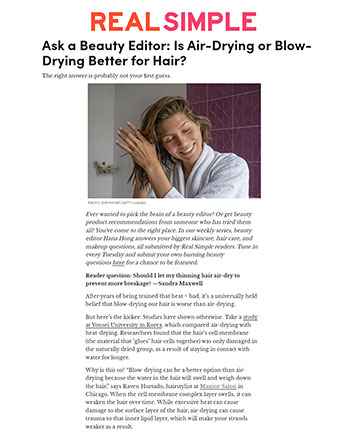Real Simple November 8, 2022
 Real Simple
Real Simple
Style
Ask a Beauty Editor: Is Air-Drying or Blow-Drying Better for Hair?
The right answer is probably not your first guess.
Ever wanted to pick the brain of a beauty editor? Or get beauty product recommendations from someone who has tried them all? You've come to the right place. In our weekly series, beauty editor Hana Hong answers your biggest skincare, hair care, and makeup questions, all submitted by Real Simple readers. Tune in every Tuesday and submit your own burning beauty questions here for a chance to be featured.
Reader question: Should I let my thinning hair air-dry to prevent more breakage? —Sandra Maxwell
After years of being trained that heat = bad, it’s a universally held belief that blow-drying our hair is worse than air-drying.
But here’s the kicker: Studies have shown otherwise. Take a study at Yonsei University in Korea, which compared air-drying with heat-drying. Researchers found that the hair’s cell membrane (the material that "glues" hair cells together) was only damaged in the naturally dried group, as a result of staying in contact with water for longer.
Why is this so? “Blow-drying can be a better option than air-drying because the water in the hair will swell and weigh down the hair,” says Raven Hurtado, hairstylist at Maxine Salon in Chicago. When the cell membrane complex layer swells, it can weaken the hair over time. While excessive heat can cause damage to the surface layer of the hair, air-drying can cause trauma to that inner lipid layer, which will make your strands weaker as a result.
Over time, something called hygral fatigue happens, i.e. repeated swelling of the hair. If you wash your hair frequently, the constant swelling and de-swelling of the hair can aggravate hair-thinning and lead to more breakage. If you have fine hair, it will cause the hair to stretch and appear more limp, says Hurtado. If you have textured or curly hair, it will make your strands more frizzy. And the worst case scenario is if you have overly dense hair, where the damp environment can attract bacteria and fungus, leading to scalp problems.
That being said, it’s important to note that not all blow-drying is better for hair—it’s only beneficial when done right. To get the best result, timing is key. First and foremost, never brush hair when it’s wet. “After you wash your hair, the hair cuticles are wide open,” says Stephanie Angelone, master stylist at RPZL Hair Extension & Blowout Bar in New York City. “This is when your hair is at its most delicate. Brushing when the cuticle is wide open is when you can cause breakage.”
And it’s important to note that air-drying does come into play—in fact, the most ideal drying routine is a combination of blow-drying and air-drying (also referred to as rough-drying). According to experts, this is the best step-by-step routine for drying hair.
1. Pat-dry hair with a microfiber towel. Be gentle and squeeze out excess water—don’t swish back and forth as that can also lead to breakage.
2. Apply your hair products, including any heat protectants, leave-in conditioners, and detangling mists, from mids to ends.
3. Setting the hair-dryer on the lowest heat setting, move it in a constant motion around the head until hair is 80 percent dry. (Expert tip: Blow-dry the ends first since that’s where most of the water holds.) Don’t rush while blow-drying—take manageable sections to evenly heat and dry your hair. Avoid using a brush or any other tools at this step.
4. Once your hair is 80 percent dry (it should still feel a little damp), gently brush out your hair with a soft-bristled brush. Hair regains strength and elasticity at this point, but is still just damp enough to be malleable, so it’s the best time to style as you wish.
